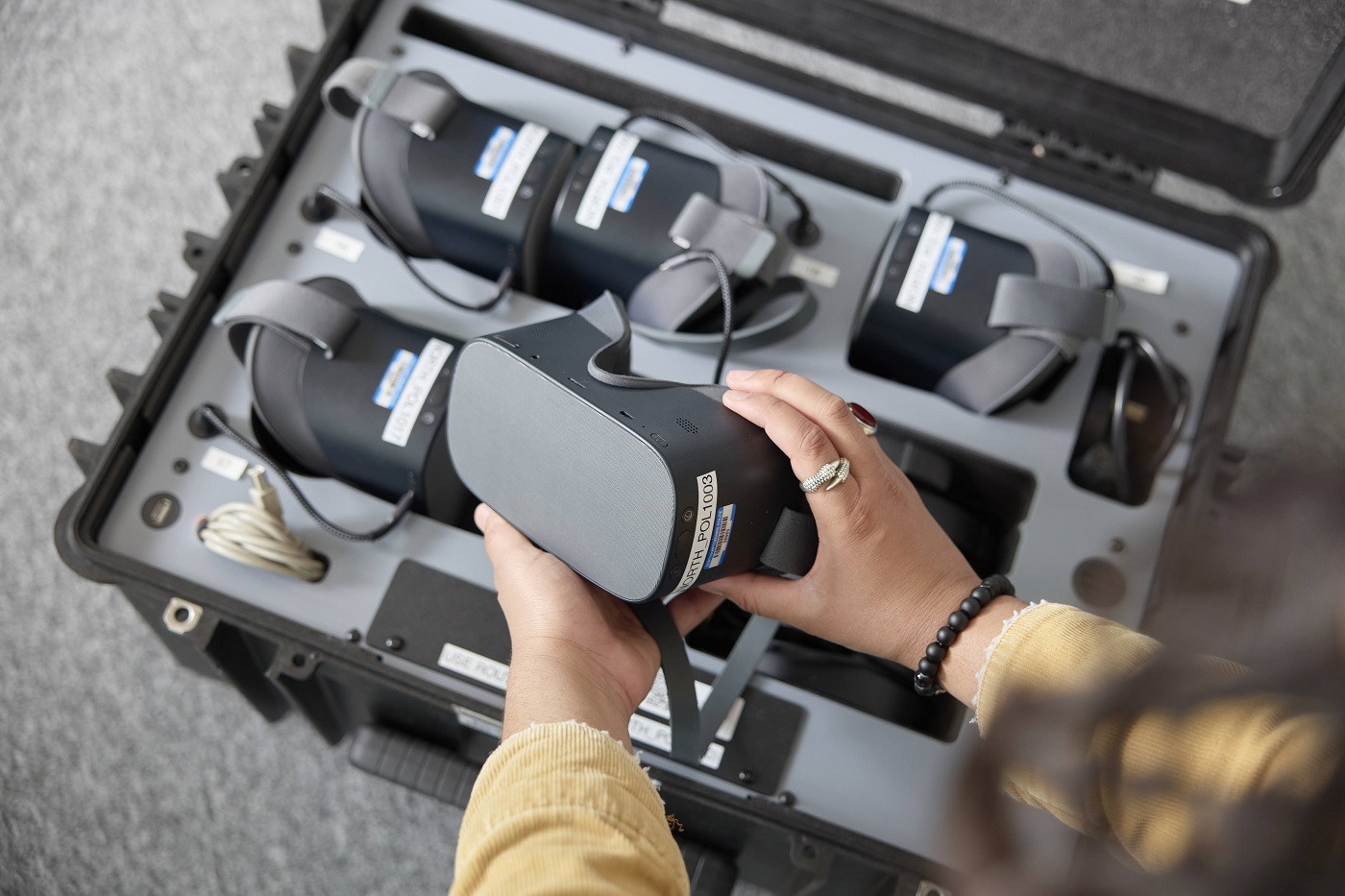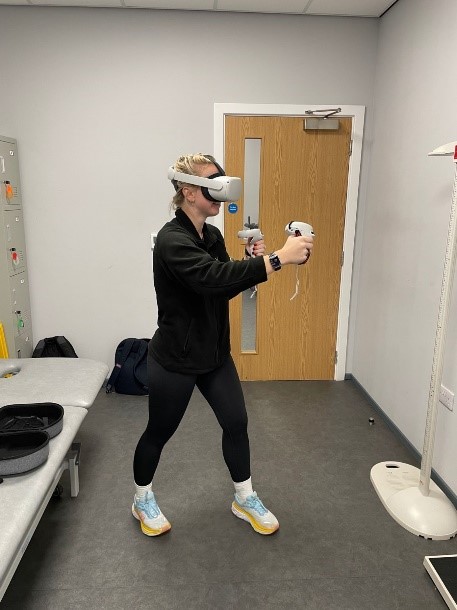The Impact of a Virtual Reality Intervention on Patients with Multiple Sclerosis Diagnosis
Date 21 May 2024
21.05.2024Insights from the Centre for Active Digital Enhancement (CADE)'s event held on 22 March 2024, in which Rob Smith, a Lecturer in Sport Rehabilitation and Conditioning at UON, and one of his students, Sophie Luscombe, presented on the developing role of Virtual Reality (VR) within the field of rehabilitation.

On 22 March 2024, the Centre for Active Digital Education’s Extended Reality Special Interest Group held an event in which Rob Smith, a Lecturer in Sport Rehabilitation and Conditioning at the University of Northampton, and one of his students, Sophie Luscombe, presented on the developing role of Virtual Reality (VR) within the field of rehabilitation.
Rob provided an overview of the role of (VR) with Sport Rehabilitation noting that the use of exergaming is not a new concept having been around since the early 1980’s with the use of more common commercial products such as Dance, Dance Revolution (Behrenshausen, 2007). However, the use of VR within rehabilitation is a relatively new field with evidence pointing towards reducing pain (Nambi et al., 2021) and improving overall muscle function (Gűr & Başar, 2023) with research also showing benefits within sporting settings when used at low intensity levels (Snyder et al., 2011). Its use in a health-based setting is slightly more established. However, this research has mainly focused on conditions where possible neurological function has been lost in the hands.
Following this, a key focus of the presentation was the current research conducted by Sophie as part of her dissertation module which focused on exploring the effects of a VR training programme on Multiple Sclerosis (MS) patients. Below is a brief overview of the study’s rationale, key findings and next steps.
Sophie outlined how this area of research is growing within the field of rehabilitation and the aim of this study was to see whether the use of VR, in addition to physical exercise, could improve mobility and cognitive function of women with MS, ‘an autoimmune disease causing the immune system to attack the protective myelin sheath surrounding nerves, causing a wide range of symptoms including tingling and numbness in the limbs, mobility issues and a cognitive decline’ (Weinstock-Guttman and Jacobs, 2000).
Within her literature review, Sophie found that studies identifying that gamification, and especially the use of VR, is an emerging field of technology that allows the user to encounter virtual worlds and environments as part of an interactive game and that instead of using exercise equipment, the use of VR has introduced a possible, and successful alternative method to provide similar effects to provide improving mobility for MS patients within their own home (Ozkul, et al., 2020; Molhemi, et al., 2021).

In total, eight (n=8) participants took part in the data collection of Sophie’s study with each participant being randomly allocated to either the control group or the VR group. The control group took part in a one-hour gym-based exercise programme, three days per week for six weeks. The VR group also carried out a one-hour gym-based exercise programme, three days per week for six weeks but also conducted 15 minutes of VR training straight after every exercise session. The game Beat Saber (developed by Beat Games) was used on the VR headsets and users had to hit oncoming blocks displayed on their headsets via laser beams using handheld devices corresponding to the way each arrow was orientated – up, down, left, right or diagonally.
In terms of findings, Sophie found that there were no real significant differences in reaction times of the participants until toward the end of the intervention at Week 6 where those with MS diagnoses started to show slightly improved reaction times. Interestingly, she found another difference within the control group; between Week 1 and Week 6, there was actually a decline in reaction time, not the improvement that was expected. Therefore, the data collected suggests that although the use of VR intervention cannot cure the symptoms of MS, it can be used to delay the decline of cognitive function yet even when positive outcomes were found, they did not materialise until toward the end of the programme suggesting that the VR intervention needs to be conducted for at least six weeks for any changes to commence.With regards to next steps, Sophie would like to continue to explore this area and conduct wider study with a larger sample size over a longer period of time as well as using the intervention, and other elements of VR with patients with different types and varying degrees of MS within different settings including hospitals, gyms and their own homes.
The Extended Reality SIG would like to thank Rob and Sophie for their time presenting on the developing role of XR within the world of rehabilitation.
References
- Behrenshausen, B.G. (2007) Tiward a (kin)esthetic of video gaming: The case of Dance Dance Revolution. Games and Culture. 2(4), pp.335-354.
- Gür O, Başar S. The effect of virtual reality on pain, kinesiophobia and function in total knee arthroplasty patients: A randomized controlled trial. The Knee. 45, pp.187-197.
- Molhemi, F., Monjezi, S., Mehravar, M., Shaterzadeh-Yazdi, M., Salehi, R., Hesam, S., and Mohammadianinejad, E. (2021) Effects of Virtual Reality vs Conventional Balance Training on Balance and Falls in People with Multiple Sclerosis: A Randomised Controlled Trial. Archives of Physical Medicine and Rehabilitation. 102(2), pp.290-299.
- Nambi, G., Abdelbasset, W.K., Alrawaili, S.M., Alsubaie, S.F., Abodonya, A.M., and Saleh, A.K. (2021) Virtual reality or isokinetic training; its effect on pain, kinesiophobia and serum stress hormones in chronic low back pain: A randomized controlled trial. Technology and Health Care: Official Journal of the European Society for Engineering and Medicine. 29(1), pp.155-166.
- Ozkul, C., Guclu-Gunduz, A., Yazici, G., Guzel, N.A., and Irkec, C., (2020) Effect of immersive virtual reality on balance, mobility and fatigue in patients with multiple sclerosis: A single-blinded randomized controlled trial. 35.
- Snyder, C.W., Vandromme, M.J., Tyra, S.L., Porterfield, J.R Jr., Clements, R.H,. Hawn, M.T (2011) Effects of virtual reality simulator training method and observational learning on surgical performance. World Journal of Surgery. 35(2), pp.245-252.
- Weinstock-Guttman, B., and Jacobs, L.D. (2000) What is New in the Treatment of Multiple Sclerosis? Drugs. 59(3), pp.401-410.
